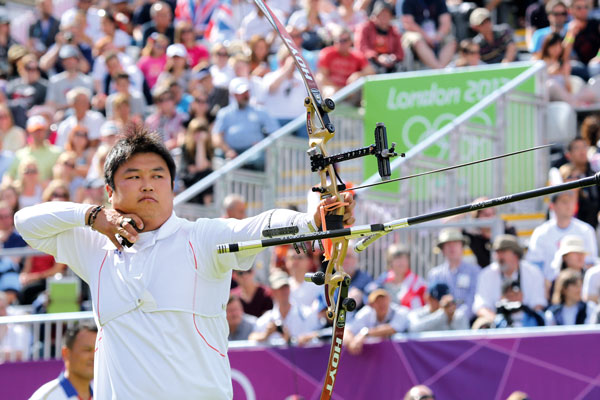Doug Denton, senior recurve engineer at Hoyt answers your questions and discusses the difference between two risers in the same product line and their affect on performance and feel…

Shooters like Oh Jin Hyek that still prefer the HP geometry
Q. Can you explain briefly what the main differences are in bow geometry
between two risers in the same product line, and how that affects the
bow’s performance and feel from a design perspective?
A. OK, so first let’s talk about what I would consider real geometry of a recurve bow. The main part of the geometry doesn’t really change whether you have a 17 inch riser or a 27 inch riser. In the past you’ve heard Hoyt talk a lot about original Earl Hoyt geometry – now the original Earl Hoyt geometry was founded back in the early eighties.
Earl Hoyt junior developed the original die cast Gold Medallist, and it was really the staple of Olympic recurve bows throughout the world; since the development of that riser, that geometry has been used on every platform across the world, so all major bow manufacturers used that geometry to develop recurve bows. But when we talk about geometry, I refer to it as if you could draw an imaginary line from the dovetail to dovetail of each limb, and measure from that imaginary line to the centre of the cushion plunger.
So that is really the fundamental geometry. When we talk about, say, our new Satori recurve line, or our new Olympic formula Faktors and the Epic, Grand Prix Epic Olympic recurve, that measurement, from that imaginary line to that cushion plunger hole is exactly the same, regardless of whether it is a 17 inch riser or a 25 inch riser.
So, when we talk about performance differences between this traditional Satori traditional line versus our Olympic line it really comes down to the length of those risers. The length of the handle will change the poundage of the limb, how it reacts to one’s draw length. For example, when we look at the Epics; we have the 25 inch Epic and the 23 inch Epic, and we’ll have a 2lb shift between those if we’re using the same limb (Hoyt mark all limbs up for poundage at a 28 inch draw) to go from one bow to the next, which some people can confuse a little bit with a geometry shift. In some aspects maybe it is a geometry shift, but I look at it as it’s not – it’s the length of a handle. I really focus in on the geometry of a recurve with regards to that imaginary triangle that we just discussed.
Now, the difference in geometry. The Faktor HP does have a true different geometry, and the Faktor HP was developed off the geometry that Oh Jin Hyek won the 2012 Olympics with, which was the formula HPX. That geometry really came about by working with some of the top athletes throughout the world to develop a riser geometry that was a steadier, faster platform for a Olympic recurve bow, and it was very successful, especially when you look at the 2012 games, and then since the 2012 games the wins that that geometry has had. Now we offer both geometries with our high-end Olympic recurve line simply because not all archers are built the same, and I think to have the two different geometries is really critical for different styles of shooting and what goals people are really looking for.
A lot of the feedback that I got from the HPX was that it was the most accurate bow that they’ve ever shot; but when they got under pressure with their particular style of shooting, they felt like maybe it wasn’t as forgiving and so we had some of those shooters like Brady Ellison that switched back to an early Hoyt-type geometry, which would be the regular Faktor today, but then we have shooters like Oh Jin Hyek that still prefer the HP geometry. Well, Oh Jin Hyek shoots both and he’s undoubtedly been shooting both of them extremely well.
But what it really means with regards how I would talk to potential shooters of both models is, if they had a shorter draw length, say 28½ inches or less, to get the extra performance of the Faktor HP I think would be definitely be a bonus, because that would give them more performance outside, and less wind drift, as it’s a faster arrow for a little shorter draw length.
If they have a draw length of over 28½ inches then obviously both bows are really suited well for you. I always suggest if you can try both of them, that’s really the best way to do it. I really like the HP geometry, because for me I actually have a much steadier aim when I’m shooting that bow, and I’ve played around with different stabilisation to see if it will solve in the stabilisation of the bow or the poundage of the bow, and it’s simply that geometry for me.
I have a 29½ inch draw length, and for me it is such a stable, controlled shot and well-aimed bow, and when you have a bow that’s aiming really steady for you, whether you are shooting at 70m or 18m you have more confidence to continue that shot through the clicker and execute a really good shot, so for me it’s extremely helpful.
This article originally appeared in the issue 113 of Bow International magazine. For more great content like this, subscribe today at our secure online store: www.myfavouritemagazines.co.uk

